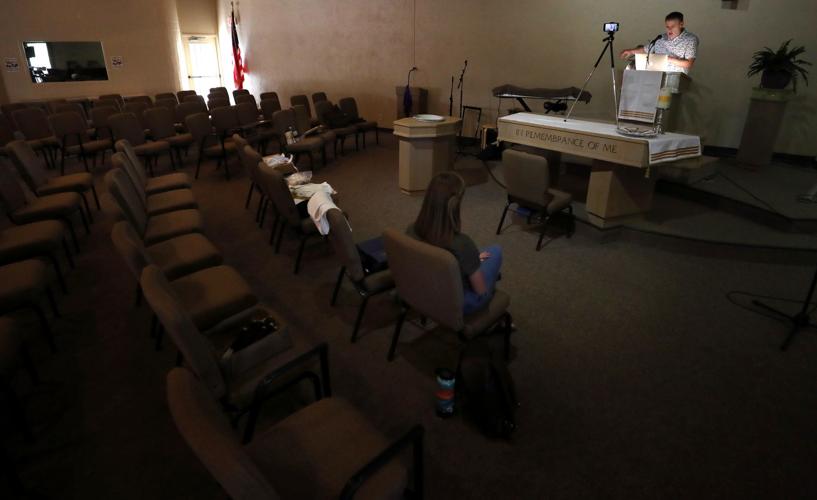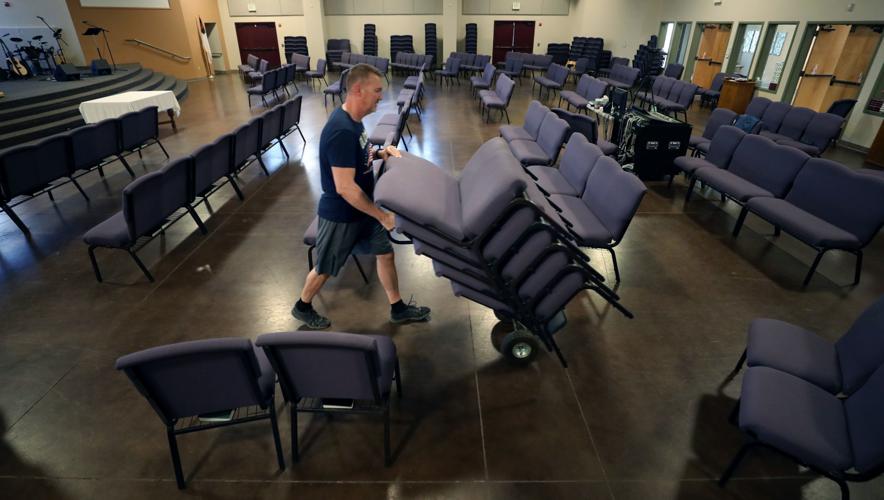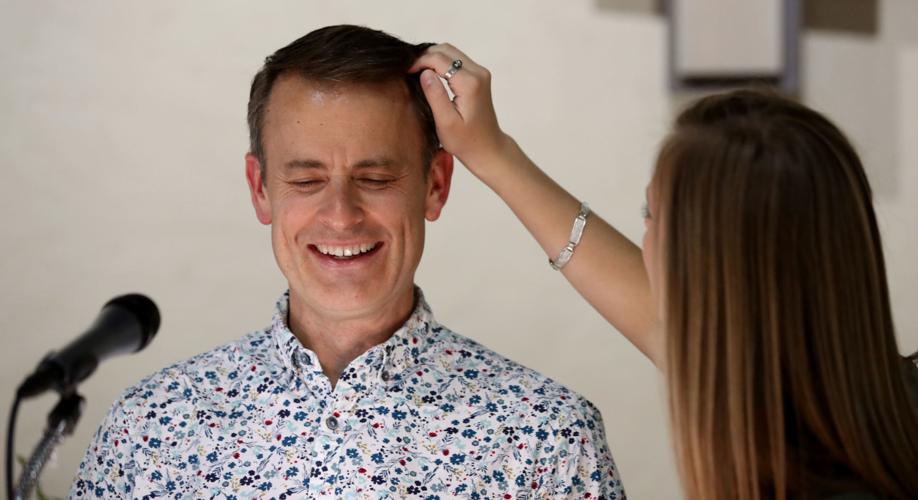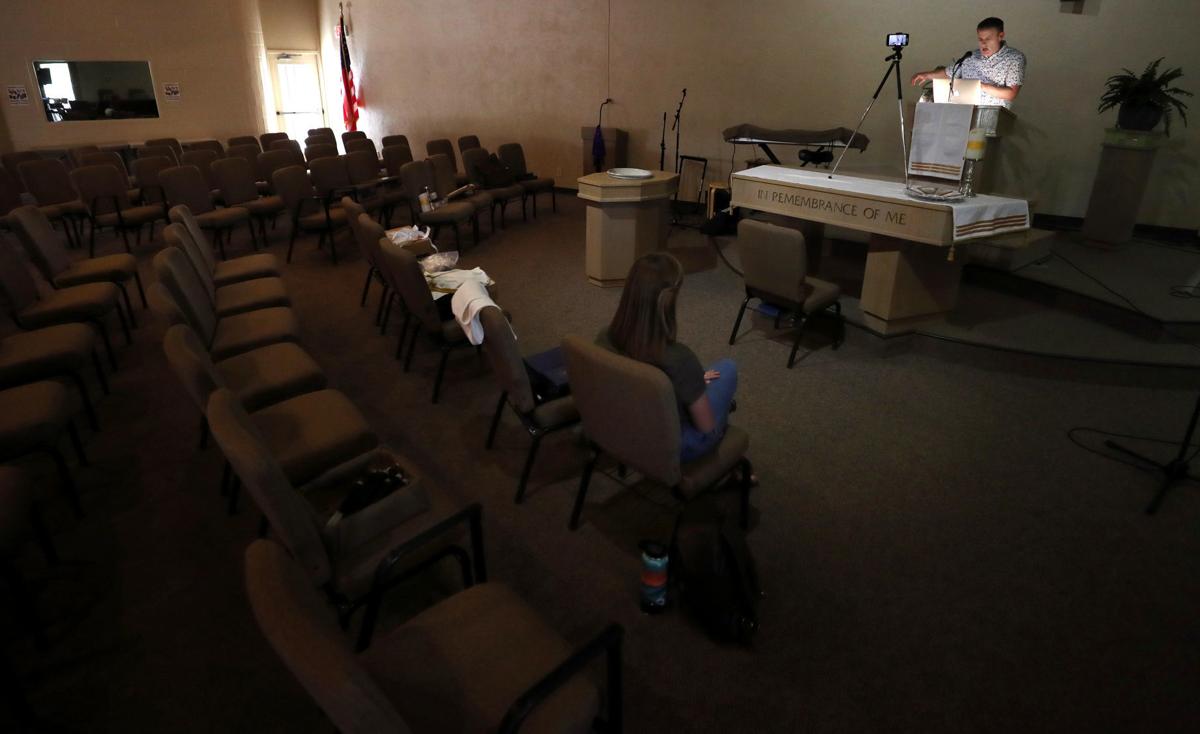As most Tucson churches remain closed, those that are open or planning to reopen are instituting measures ranging from reduced capacity to asking parishioners not to touch common surfaces to silencing singing, all in attempt to limit the spread of coronavirus.
Unlike a number of other states, Arizona did not shut down religious centers, but many opted to close in the name of public health.
Social distancing planning is now underway, and some places will recommend or require the use of masks.
The decisions are particularly geared toward older worshippers who are at higher risk for contracting the virus and are most likely to attend services.
“Nothing magical about May 15”
In the last couple months, Pastor Jonathan Smith of the Tucson Sharon Seventh-day Adventist Church, has used both his master’s in public health and master’s in pastoral studies to navigate his congregation through the pandemic.
The midtown church closed after its March 7 service, earlier than most Tucson churches.
“I saw there was no way for me to keep our people safe and together from a public health perspective,” Smith said.
He has since been researching and sharing evidence-based information with the members of his church. The information he provides goes beyond politics, he said. He’s in contact with Pima County epidemiologists and looks for new information from the Arizona Department of Health Services.
Seventh-day Adventist churches historically have a large percentage of black parishioners, and racial and ethnic minority groups appear to be at higher risk of contracting the coronavirus.
“The effects of COVID-19 on the health of racial and ethnic minority groups is still emerging; however, current data suggest a disproportionate burden of illness and death among racial and ethnic minority groups,” the Centers for Disease Control and Prevention says.
The CDC website says economic and social conditions more common in ethnic minorities are factors that could lead to minorities being at higher risk of infection or more severe illness due to COVID-19.
Despite a state stay-at-home order having been lifted earlier this month, the church has set its opening date for Aug. 1, waiting out the pandemic a little longer and allowing renovations to be completed, Smith said.
“We just decided that there’s nothing magical about May 15 that made it safe to go back to our church,” he said.
The Episcopal Diocese of Arizona has formed a task force that includes two physicians who will weigh in as guidelines are set for a phased reopening, said the Right Rev. Jennifer A. Reddall, bishop of the Episcopal diocese.

Brian McKinley carts out chairs for temporary storage after the seating at Rincon Presbyterian Church was rearranged to meet COVID-19 guidelines.
Reddall said many parishioners and clergy in Episcopal churches are older than 60. Each church is required to submit a safety plan before the diocese will consider granting approval to reopen, she said, adding that reopening is not required if church leaders are not comfortable doing so.
Clergy are also told they don’t have to go back to the church if they don’t feel comfortable, Reddall said. On the flip side, the Episcopal diocese won’t prevent any group from going to church, even those considered vulnerable, because older people might feel more isolated or be unable to access online services, she said.
“That’s why we’re trying to be so strict I think about the guidelines of what is required in order to reopen for public worship,” Reddall said.
Episcopal churches in Arizona are moving into Phase 2 of reopening, allowing either 25% of their occupancy or 50 people, whichever is smaller, when they reopen.
The diocese is requiring a sustained reduction in cases for at least 14 days in each county before allowing churches to move on to Phase 2.
Rabbi Yehuda L. Ceitlin of Chabad Tucson said when their synagogues reopen, Jewish leaders will remind people there is no religious obligation for them to visit the synagogue if they’re not yet comfortable, “because health comes first and life is sacred.”
“I think that’s a clear enough instruction for anyone who is above a certain age that they don’t have to be here,” Ceitlin said. “We don’t feel like we have the right to tell people they’re not allowed to come.”
Chabad Tucson leaders have been in contact with medical professionals as they decide when to reopen and how to do so safely, Ceitlin said.
“Our top priority is obviously saving, guarding and protecting human life,” he said.
The Roman Catholic Diocese of Tucson is urging its parishioners older than 65, and anyone with chronic health conditions to stay home as Catholic churches in Southern Arizona start to reopen for outdoor Holy Communion this weekend. The diocese is not allowing public Masses yet, though parishes with approved safety plans could celebrate Mass again as soon as May 29.
Given the highly fluid nature of the pandemic, the Roman Catholic Diocese of Tucson has told parishioners that churches could close again should the situation worsen.
“We will not let our love for the practice of our faith overcome our call to be faithful citizens attentive to the common good,” Bishop Edward J. Weisenburger said.
The Islamic Center of Tucson has leaned heavily on the scientific community and health-care professionals in deciding to remain closed.

Abby Tittle gets her dad’s hair just right before John Tittle records his weekly sermon in the sanctuary of the east-side Immanuel Presbyterian Church.
CONNECTING VIRTUALLY AND BEYOND
Several dozen places of worship across the Tucson area have gone virtual, offering some form of online services during the pandemic.
When Pastor John Tittle of Immanuel Presbyterian Church realized the church would have to close its doors, he turned to his tech-savvy 17-year-old daughter for help.
Abby Tittle used to have a YouTube channel in middle school, took a visual media class at Cienega High School last school year and has always been interested in photography and videography.
Those skills have come in handy as she’s helped her father prerecord sermons and edit them, putting together a weekly video for the church’s congregation to access online.
Within five days after closing Immanuel, Abby created a YouTube channel for the east-side church and linked it to the church’s website and Facebook page.
“We’re looking to a 17-year-old to help a church that’s a lot older than that to help us through,” John Tittle said. “We’ve provided coaching either through phone calls or emails to elderly members who are having a hard time navigating and they have adjusted amazingly well.”
Every week, Abby records her father delivering a sermon at their home, at the church and sometimes outdoors. She also brainstorms ideas with worship leaders and records them singing individually in their homes.
Abby Tittle said she spends 12 hours or more each week editing video components to put together their weekly service.
She has learned a lot and enjoys getting to know church leaders she otherwise wouldn’t have become close with.
It has also been a challenge to combine two services into one video, Abby Tittle said. The church’s 8:30 a.m. service is more alternative, with a band playing music, and the 11 a.m. service is more traditional, generally attended by older members of the congregation, she said.
For a church with a high percentage of members older than 60, Abby Tittle’s skills have been helpful, John Tittle said. It has also been a great way for the two to bond during the pandemic, they both said.
She’s grateful for the opportunity to grow her skills and for her dad, who has always treated her like an adult and was able to challenge her, Abby Tittle said.
“When everything first started happening I just kind of felt hopeless, like I couldn’t do anything to help,” she said. “So I’m really glad that I’m able to help provide a service that people can watch every week to kind of encourage them.”
PRESSING PAUSE ON CHOral music
After dozens of members from a single choir contracted the coronavirus, leaving two dead, in Washington state, the CDC said the act of singing may have contributed to transmission through the air, given the singers’ proximity.
The declaration caused a number of places of worship to press pause on choir services, including the Episcopal Diocese of Arizona.
Reddall, the bishop of the Episcopal Diocese, started singing in a church choir when she was 6 and found her calling to the priesthood while singing in a professional church choir.
“The idea that I’m not going to be able to pray the way that I love to pray in public is really hard,” Reddall said. “But that said, I don’t think Jesus wants me to kill someone by singing.”
She said getting people sick through singing is too much of a risk for the church. The diocese is talking to church musicians to brainstorm ways to incorporate music while keeping services safe for everyone.
The Rev. Ken Archer of St. Paul’s United Methodist Church said singing has traditionally been a big component of all three of the church’s weekly services, with a choir, a praise team and university singers leading hymns. The east-side church also shows hymn lyrics on a screen for parishioners to sing along.
“It is a big issue, and we would rather continue the non-in-person worship for a little while longer than to put our people in a situation where, you know, when there’s music they’re going to want to sing,” Archer said.
Immanuel Presbyterian Church is considering either showing a prerecorded musical performance when it reopens or having only one or two people sing during services, Pastor John Tittle said, though nothing is set in stone.
“There will be a time where we’ll have a new normal and we’ll be able to enjoy many of the things that we did before,” he said. “Things will change for sure, but initially it’s going to be very limited and cautious.”
Photos: Flags placed on graves at Tucson cemetery for Memorial Day
Memorial Day flags
Updated
Jaime Aviles, who served in the U.S. Navy from 1974-79, places American flags on the graves of military veterans for Memorial Day at Evergreen Cemetery, 3015 N. Oracle Road, Tucson, on May 23, 2020. Aviles and wife Cathy joined other members of the American Legion and Veterans of Foreign Wars to honor nearly 9,000 veterans buried at Evergreen Cemetery. Aviles' father served aboard the famous aircraft carrier USS Lexington in World War II. His brother and uncles served in Vietnam, Korea and World War II. Aviles' son is a U.S. Navy commander and graduate of Canyon del Oro High School and the U.S. Naval Academy.
Memorial Day flags
Updated
Jaime Aviles, right, who served in the U.S. Navy from 1974-79, along with wife Cathy Aviles, places American flags on the graves of military veterans for Memorial Day at Evergreen Cemetery, 3015 N. Oracle Road, Tucson, on May 23, 2020. They joined other members of the American Legion and Veterans of Foreign Wars to honor veterans who have died.
Memorial Day flags
Updated
Bob Crawford, who served in the U.S. Navy from 1963-91, dusts off a grave marker as Bill Garris, U.S. Air Force, 1966-70, places American flags on the graves of military veterans for Memorial Day at Evergreen Cemetery, 3015 N. Oracle Road, Tucson, on May 23, 2020.
Memorial Day flags
Updated
American flags on the graves of military veterans for Memorial Day at Evergreen Cemetery, 3015 N. Oracle Road, Tucson, on May 23, 2020.
Memorial Day flags
Updated
Bill Garris of American Legion Post 132, who served in the U.S. Air Force from 1966-70, carries American flags to place on the graves of military veterans for Memorial Day at Evergreen Cemetery, 3015 N. Oracle Road, Tucson, on May 23, 2020.
Memorial Day flags
Updated
Bill Garris, left, and Bob Crawford, of American Legion Post 132, place American flags on the graves of military veterans for Memorial Day at Evergreen Cemetery, 3015 N. Oracle Road, Tucson, on May 23, 2020.
Memorial Day flags
Updated
Members of the American Legion place American flags on the graves of military veterans for Memorial Day at Evergreen Cemetery, 3015 N. Oracle Road, Tucson, on May 23, 2020.
Memorial Day flags
Updated
Members of the American Legion place American flags on the graves of military veterans for Memorial Day at Evergreen Cemetery, 3015 N. Oracle Road, Tucson, on May 23, 2020.
Memorial Day flags
Updated
American flags on the graves of military veterans for Memorial Day at Evergreen Cemetery, 3015 N. Oracle Road, Tucson, on May 23, 2020. The Veterans of Foreign Wars and American Legion placed nearly 9,000 flags at veterans' graves at the cemetery.







